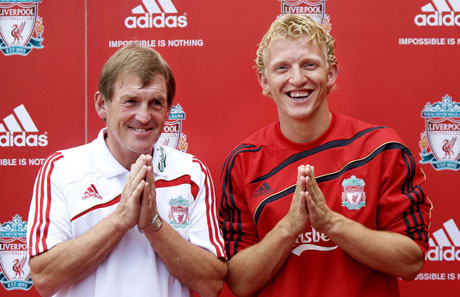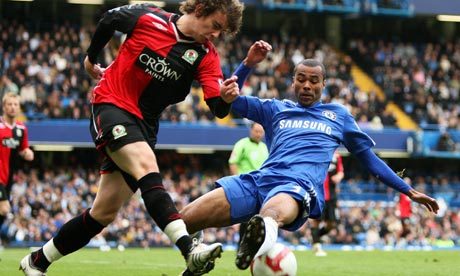-
Recent Articles
The Midfielder as Centerback
 Marcelo Biesla and Josep Guardiola are both managers who play a very high line with their respective sides and who both demand that all players be technically proficient with the ball. Part of playing...
Marcelo Biesla and Josep Guardiola are both managers who play a very high line with their respective sides and who both demand that all players be technically proficient with the ball. Part of playing...Understanding the 4-4-2 Diamond
DEFENCE Despite the fact that there are four ways to play a diamond formation on FM, the differences between them are few and usually subtle. As a starting point, one thing each of them do have...3 at the back and the 4-4-2 Diamond
 Last week Chelsea v Liverpool became the biggest tactical talking point of the season. Liverpool revived the the 3 man defence that Kenny debuted against Stoke. While with the introduction of Torres for £50m...
Last week Chelsea v Liverpool became the biggest tactical talking point of the season. Liverpool revived the the 3 man defence that Kenny debuted against Stoke. While with the introduction of Torres for £50m...How To Set Up A Back Four
 Last year, I wrote a guide about how to play a simple 4-4-2. One of the major components of that is the back four. In fact, most modern formations build upon four defenders; two full backs and two centre...
Last year, I wrote a guide about how to play a simple 4-4-2. One of the major components of that is the back four. In fact, most modern formations build upon four defenders; two full backs and two centre...Building Your Defence: Full Backs
 The modern full back is quickly becoming one of the most important players on the team sheet, infact even back in the days of Brian Clough, fat ed' argued that because of the space these players get in the final...
The modern full back is quickly becoming one of the most important players on the team sheet, infact even back in the days of Brian Clough, fat ed' argued that because of the space these players get in the final...
JOIN
Warning: simplexml_load_file(http://feedburner.google.com/api/awareness/1.0/GetFeedData?uri=fmbritain) [function.simplexml-load-file]: failed to open stream: HTTP request failed! HTTP/1.0 404 Not Found
in /home/geordieg/public_html/wp-content/plugins/feedburner-circulation/feedburner-circulation.php on line 76
Warning: simplexml_load_file() [function.simplexml-load-file]: I/O warning : failed to load external entity "http://feedburner.google.com/api/awareness/1.0/GetFeedData?uri=fmbritain" in /home/geordieg/public_html/wp-content/plugins/feedburner-circulation/feedburner-circulation.php on line 76
12,748 READERS - SUBSCRIBE NOW TO OUR FOOTBALL MANAGER NEWSLETTER
Get the latest FM news & best community content delivered directly to your e-mail inbox!
Tactical Theorems & Frameworks ’09: Match Strategies
Written by: Richard Claydon
Category: Strategy
Posted on: November 23, 2008
November 23, 2008
Match Strategies
The Standard Match Strategy
This is arguably the most important of all match strategies as, by carefully balancing risk and reward, it enables a manager to assess the match situation and how well his team is playing prior to switching to a more specialised tactical plan. It is an ideal starting strategy for all short-odds matches. By carefully watching the match the manager can then decide to be more aggressive or cautious or to stick with the standard approach if things are going well.
Tactical Instructions
• Mentality System: Upper Defensive – Lower Attacking (min 5 players on Normal)
• Player Roles: 3 Defend, 4 Support, 3 Attack
• Closing Down: Low Normal- High Normal
• Passing Pattern: Defend (low direct), Support (mixed), Attack (low mixed)
• Tempo: Normal
• Width: Normal
• Time Wasting: Normal
• Tackling: Normal
• Focus Passing: Mixed
• Marking: Defend & Support (Tight/Man), Attack (Loose/Zonal)
• Creative Freedom: Defend (Low), Support (Normal), Attack (High)
• Free Roles: Attack (one)
• Counter Attack: Optional
• Play Offside: Optional
The Attacking Match Strategy
This strategy is best employed for matches that you are favourites to win and expect to dominate possession in your opponent’s half. It aims to exploit space in the final third by employing fast tempo, direct, attacking orientated passing supported by a defensive strategy aimed at recycling possession. It focuses heavily on getting players forward and into space and allows them the creative freedom to express themselves.
Tactical Instructions
• Mentality System: High Normal – Upper Attacking (min 5 players on Attacking)
• Player Roles: 3 Defend, 2 Support, 5 Attack
• Closing Down: Mid Normal – High Often
• Passing Pattern: Defend (short), Support (mixed), Attack (direct)
• Tempo: Fast
• Width: Wide
• Time Wasting: Low
• Tackling: Hard
• Focus Passing: Down Both Flanks
• Marking: Defend & Support (Tight/Man), Attack (Loose/Zonal)
• Creative Freedom: Defend (Low), Support (Normal), Attack (High)
• Free Roles: Attack (three)
• Counter Attack: No
• Play Offside: Yes
The Defensive Match Strategy
This strategy is best employed for matches that you are favoured to lose and in which you expect your opponent to put you under extended pressure. It aims to keep men behind the ball, to restrict space in your half, to slow things down and to frustrate the opposition. It relies on direct balls to the forwards followed by sharp and quick passing interchanges to score goals on the counter.
Tactical Instructions
• Mentality System: Defensive – Mid Normal (min 5 players on Defensive)
• Player Roles: 5 Defend, 2 Support, 3 Attack
• Closing Down: Low – Mid Normal
• Passing Pattern: Defend (direct), Support (mixed), Attack (short)
• Tempo: Slow
• Width: Narrow
• Time Wasting: High
• Tackling: Easy
• Focus Passing: Through the Middle
• Marking: Defend & Support (Tight/Man), Attack (Loose/Zonal)
• Creative Freedom: Defend (Low), Support (Normal), Attack (High)
• Free Roles: Attack (one)
• Counter Attack: Yes
• Play Offside: No
Although the above three strategies should be enough to perform well over a full season, the more sophisticated manager has a couple more options up his sleeve, Control and Shut-up-Shop.
The Control Match Strategy
The Control Match Strategy sits between the Standard and Attacking mentality systems and has two options for deployment. The first is to slow down a match that should already be won, generally playing keep ball whilst still being able to gently probe in the final third when space opens up. The second is when a more patient approach is deemed to be necessary against a team that is sitting back and trying to frustrate. Closing down is more cautious than in Attacking strategies in order to entice the opposition out of their defensive comfort zone and free up some space. For both options, the manager has to best decide how to employ Defend, Support and Attack roles. As midfield possession is the priority, six players can be given support roles in a 2-6-2 pattern. However, should the manager prefer a more aggressive Control Strategy, a 2-5-3, 2-4-4, or 3-3-4 split should be used. For a more cautious approach, employ a 3-5-2 or 3-6-1 split.
Tactical Instructions
• Mentality System: Normal – Mid Attacking
• Player Roles: 2-3 Defend, 3-6 Support, 2-4 Attack
• Closing Down: Normal – Low Often
• Passing Pattern: Defend (low-mixed), Support (mixed), Attack (low-direct)
• Tempo: Normal
• Width: Wide
• Time Wasting: Low
• Tackling: Normal
• Focus Passing: Mixed/Down the Flanks
• Marking: Defend & Support (Tight/Man), Attack (Loose/Zonal)
• Creative Freedom: Defend (Low), Support (Normal), Attack (High)
• Free Roles: Attack (one-two)
• Counter Attack: No
• Play Offside: Optional
The Shut-up-Shop Match Strategy
Although the Shut-Up-Shop Strategy is the most defensive of the systems, one must guard against dropping its mentality system too low, which will invite pressure, and should use Defensive and Standard strategies as guiding bookends. The aim of the tactic is to frustrate the opposition by reducing space, slowing things down, keeping the ball, wasting time as much as possible and to clear the ball long when out of risk-free options. Unlike the Defensive Match Strategy, it is not looking to score on the counter, just not to concede. As possession and frustration is the priority, more players than usual will be kept behind the ball. Closing down will be aggressive up front, but cautious in midfield and defence. Defenders and support players will be looking to clear the ball, whereas Attackers will aim to maintain possession and draw fouls rather than make risky attacking passes. In terms of Defend, Support and Attack roles, the manager can choose to deploy a 6-3-1, 6-2-2, 5-4-1 or 5-3-2 split. Due to its very defensive nature, this strategy might not suit all formations, especially those with multiple attacking midfielders and forwards.
Tactical Instructions
• Mentality System: Defensive – Mid Normal (min 5 players on Defensive)
• Player Roles: 5-6 Defend, 2-4 Support, 1-2 Attack
• Closing Down: Low – Low Normal
• Passing Pattern: Defend (very direct/long), Support (mixed), Attack (very short)
• Tempo: Very Slow
• Width: Narrow
• Time Wasting: Very High
• Tackling: Easy
• Focus Passing: Through the Middle
• Marking: Defend & Support (Tight/Man), Attack (Loose/Zonal)
• Creative Freedom: Defend (Low), Support (Normal), Attack (High)
• Free Roles: Attack (one)
• Counter Attack: Yes
• Play Offside: Optional
About The Author: Richard Claydon
Tactical theory has evolved massively down the years, from Diablo-style beat-’em-alls through Cleon’s era to the present day systems inspired by wwfan’s theories. Richard is considered to be the authority on FM tactics, and was approached by Sports Interactive to help write the new tactical interface in Football Manager Live and Football Manager 2010.
Download Our Tactical Theorems '10 eBook Absolutely Free

Presenting the most comprehensive tactic design and match strategy guide to the Football Manager series ever created!
Written by FM match engine beta testers, it's 60+ pages of easy-to-read concepts and ideologies for getting your team playing exactly how you want each match! It's been downloaded over 100,000+ times to date!
Find out more information about our tactical eBook
and download Tactical Theorems '10 right now!
Written by FM match engine beta testers, it's 60+ pages of easy-to-read concepts and ideologies for getting your team playing exactly how you want each match! It's been downloaded over 100,000+ times to date!
and download Tactical Theorems '10 right now!



